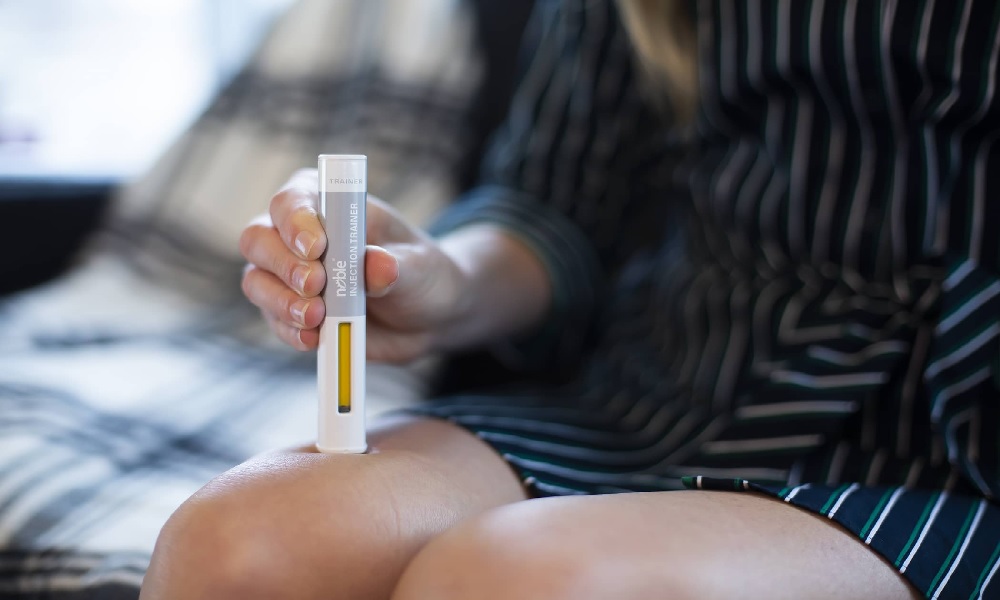Noble’s Autoinjector Training Device Advantages
Noble collaborates closely with drug delivery device manufacturers to ensure our training devices mirror their specific product designs. This is especially important when the autoinjector training device requires a particular color or other special features that can help onboard patients with confidence.
One such feature is the agitator needle simulation tip. This helps to replicate the feel of needle insertion and can help reduce patient anxiety.
Needle Sensitivity
Noble’s training device enables patients to practice their injection treatments without using a real commercial autoinjector with a drug-filled syringe or cartridge. As a result, our autoinjector training device eliminates the physiological fear associated with needles and helps patients become more confident in administering their self-injection medications.
A normalized sensitivity distribution of the needle model was evaluated for various positions in three different tissue phantoms. The electrode pairs excited by the needle are classified by their respective impedance values, and a visualization of the sensitive volume is displayed.
The colors indicate the classified tissue type of the sensitive volumes. It can be seen that the distal electrodes detect blood, whereas more distant locations show fat. The needle is, therefore, well positioned and close to its tip, as expected. The spatial distribution of the sensitive volumes is almost axisymmetric, which confirms that the needle CAD model is functioning as intended.
Reset Function
Our autoinjector training device provides the user with a non-filled drug device to overcome the physiological fear of using an actual commercial autoinjector for the first time. This is an essential element of our onboarding process, as it gives patients confidence and security in their ability to self-administer biologics.
The reusable autoinjector training device includes an outer housing and a cap/mandrel assembly. The mandrel is fabricated as one unitary part with the cap and, preferably, cannot be separated from it. A proximal end of the mandrel is fixed to an elongated, axially aligned, empty demo or dummy container, which can be made from various materials similar to real-life pre-filled medicament containers, such as syringes and cartridges.
A plunger spring is disposed of in the outer housing between the proximal end of the mandrel and the dummy container. The plunger spring is actuated to move the dummy container along axially fixed click tracks to simulate an injection procedure, whereby each click corresponds with a unit dose of simulated dispensed medicament.
Pressure Sensitivity
Noble has developed a unique training device that simulates the feel and force of a real-life commercial autoinjector, allowing patients to practice without the needle or drug. Our training device enables users to become more familiar with the process and overcome the physiological fear that can cause them to discontinue self-administering their medication.
Our trainer autoinjector training device comprises a combination cap, a reset tool (mandrel), and an outer housing. The mandrel fits over the elongated plunger rod, which is locked by a rotatable lock and prevented from moving axially within the housing by one or more specialized springs in a spiral, less tensed configuration.
The proximal end of the outer housing has a window through which a user can visually observe a scrolling ribbon that moves as the simulated injection process progresses and terminates. An audible clicker track atop the elongated plunger assembly 35 actuates as the ribbon moves, generating a sound signal. The extended inner housing contains a demo or dummy syringe or cartridge of medicament fabricated from the same materials as an actual pre-filled medicament container.
Error Correction
Noble’s multisensory training devices include audible error correction and feedback that help patients use their autoinjectors correctly. These features and patient data collection capabilities can increase adherence and confidence in self-administered injections.
A reusable device incorporating the above-described functions includes a housing or outer body four and a cap/mandrel three assembly. The syringe or cartridge, referred to herein generally as a container, is inserted into the cap 2/mandrel 3, and a combination of the cap with reset tool and a scrolling ribbon on the outer body indicates that the simulated injection process is in progress.
The rotatable lock is configured to engage directly with the plunger rod in the first position and disengage from the plunger in the second position, which initiates the simulated injection procedure. The proximal end of the outer housing is provided with a window for visually observing the scrolling ribbon during the fake injection. The rotatable lock can also be locked in the first position to prevent accidental activation of the plunger rod and to keep the spring in a less coiled or tensed condition during non-injection use.









